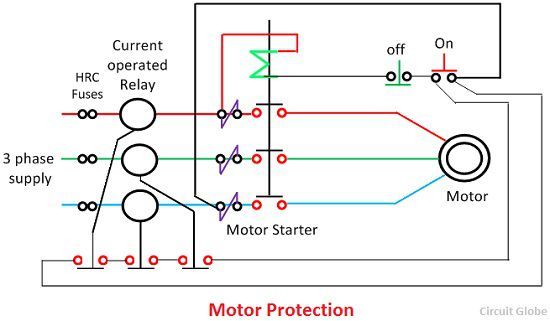The various types of the protective relays are available for protecting the motor from faults. These relays sense the abnormal operating condition and make the circuit breaker to trip. The motors provide protection against faults in windings and associated circuits, excessive overload and short circuits, under voltages, phase unbalances and single phasing, phase reversal and switching overvoltages.
The main characteristic of the relay is to reduce the operating time with the increase in the magnitude of the fault current. The various types of motor protection schemes are explained below.
1. Overcurrent Protection – This is the basic type of protection that is employed for short circuit protection of stator windings. The fuses and direct acting elements employ for the protection of the stator winding. The motor is mainly grouped into two categories, i.e., non-essential services motor and essential services motor.
The non-essential service motor provides both inverse time and instantaneous phase ground overcurrent relays for automatic tripping. The inverse phase relays are adjusted to pick up at about 3.5 to 4 times rated motor current, but to have enough time delay so as not to operate during the motor starting period.
For essential service motors, the inverse time phase overcurrent relays are usually not employed. The reason for this is to trip the motor breaker circuit automatically because the tripping of the motor requires a complete shutdown of a generator or other devices with the motor is associated.
2. Stator Overheating of Motor – The overheating of a motor is mainly due to continuous overloading, stalled rotors or unbalance stator current. For complete protection, the three phase motor should have an overload element in each phase.
For non-essential service motor protection, either long time over current relay protection or direct acting tripping are used to disconnect a motor from its sources of supply in the event of overload. If the rating of the motor is higher than 1000 kW than single relay operating with resistance detector is used instead of inverse time over current relay.
For essential service motors, the automatic tripping is desire. Hence the thermal relay is mainly used for protecting the motor from overheating.
3. Rotor overheating protection – The rotor overheating protection is more likely to occur in wound rotor motors.The increase in rotor current is reflected on stator current and the stator over current protection thereby act.
The settings of the stator over current relay generally of the order of 1.6 times full load current. This is enough to detect the rotor faults.
4. Undervoltage Protection – The motor draw excessive current when operated on under voltage and so under voltage protection can be provided by overload devices or temperature sensitive devices.
5. Unbalance and Single Phasing Protection – The unbalanced three phase supply causes the negative sequence current to flow in the motor which may cause overheating of the stator and rotor winding of the motor. The unbalanced condition provided to a motor should be such as to avoid the continuous unbalanced condition.
6. Reverse Phase Protection – The phase reversal is dangerous in some cases, such as in elevators, cranes, hoists, trams, etc. In such cases, the reverse phase protection must be provided. The phase reversal relay is based on the electromagnetic principle consists of a disc motor driven by the magnetic system.
For correct phase sequence, the disc experiences a torque in a positive direction and therefore keep the auxiliary contact closed. In the occurrence of phase reversal, the torque acting on the disc reverse and the disc start rotating in the opposite direction and hence open the auxiliary contact. Thus the magnetic coil of a starter can be de-energized, or circuit breaker can be tripped.


Hello
Your article on motor protection is well explained.Thanks